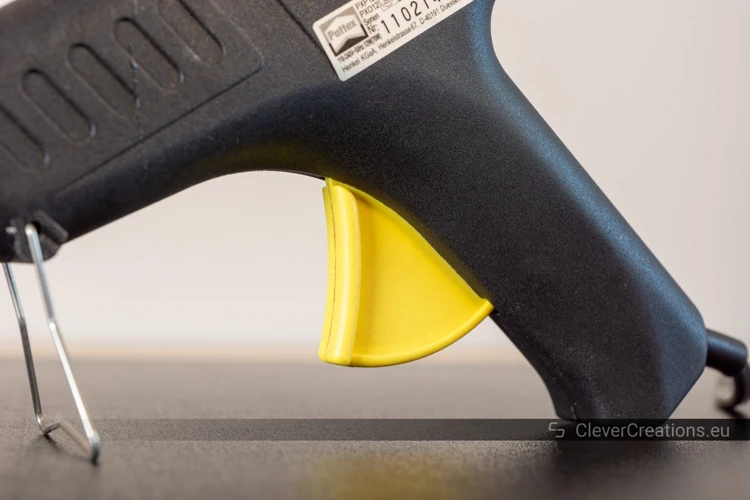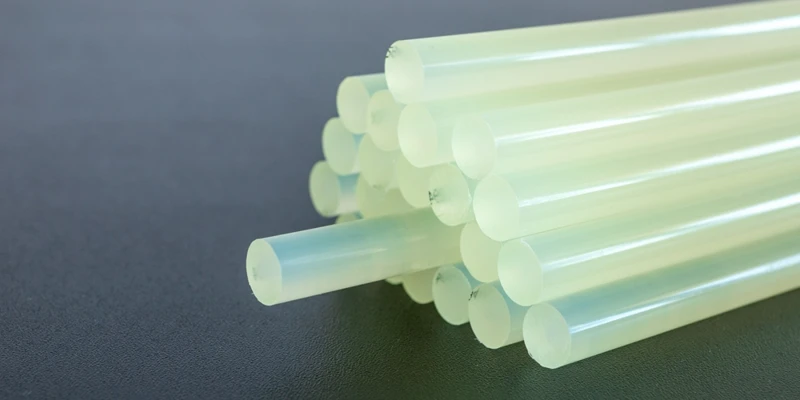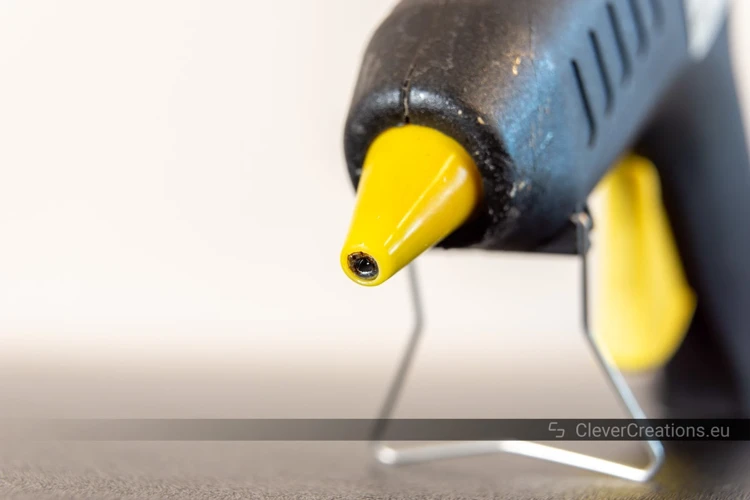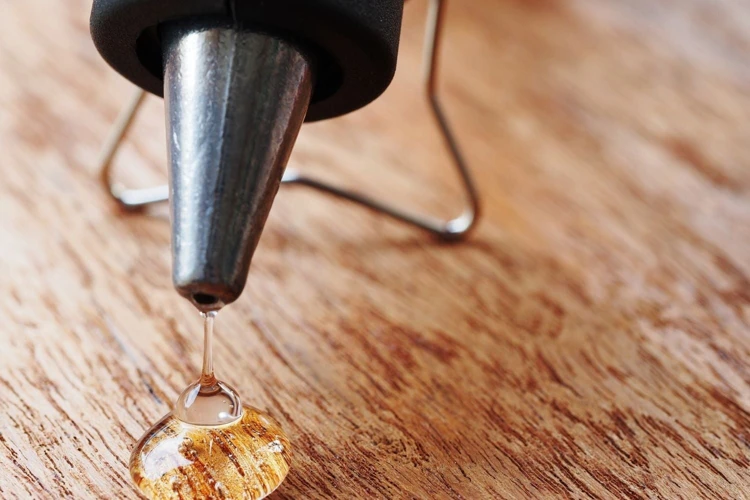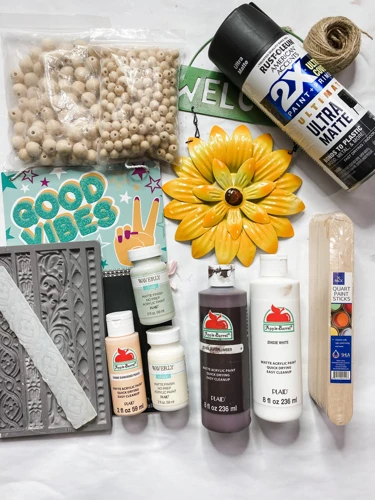Have you ever found yourself impatiently waiting for hot glue to dry on your latest DIY project? Or have you rushed to complete a project only to have the glue take longer to dry than you anticipated? Hot glue is a popular adhesive choice for many crafters and DIY enthusiasts, but its drying time can vary depending on several factors. In this comprehensive guide, we’ll explore the different factors that affect hot glue drying time, how long it typically takes hot glue to dry and cure, and share some tips and hacks to speed up or slow down the process. Let’s dive in and become hot glue drying time experts!
Factors Affecting Hot Glue Drying Time
Understanding the factors that affect hot glue drying time is important for achieving a successful project outcome. Several variables come into play when determining how long it will take for hot glue to dry and set. These range from the type of hot glue used to the amount applied, as well as the temperature and humidity of the environment. Each of these factors affects the final result, making it essential to consider them carefully before starting your project. Knowing how hot glue dries and the conditions that it requires for optimum performance can help prevent common mistakes that can compromise finished products. So, let’s dive into the details and explore the factors that can impact hot glue drying time.
Type of Hot Glue
The type of hot glue used can have a significant impact on how long it takes to dry. There are many varieties of hot glue available, each with its own unique properties. Here are some of the most common types and how they affect drying time:
- Standard hot glue: This is the most commonly used type of hot glue, and is suitable for a wide range of projects. It generally sets in 30 seconds to a few minutes, depending on the amount used and the environmental conditions.
- Fast-drying hot glue: As the name suggests, this type of glue sets much faster than standard hot glue. It can be a good choice for projects that need to be completed quickly, but it’s important to work quickly as well, since it can set in just a few seconds.
- Low-temperature hot glue: This type of glue requires less heat to melt, which can be an advantage when working with heat-sensitive materials. However, it may take longer to dry and may not be as strong as standard hot glue.
- High-temperature hot glue: This type of glue requires more heat to melt, but it is generally stronger and sets faster than low-temperature glue.
- Colored hot glue: This type of glue can be useful for certain projects where appearance is important, but it may take longer to dry than standard hot glue.
It’s important to choose the right type of hot glue for your project, taking into account the materials you’re working with and the amount of time you have available. If you’re unsure which type to use, consider doing a small test before starting your project to see how the glue reacts. Also, keep in mind that different brands of hot glue may have slightly different drying times and other characteristics.
You can find more information about how to use hot glue for specific projects by clicking on the following internal links:
- How to Fix a Glue Gun
- How to Glue Pencils Together
- How to Glue Cardboard
- How to Glue Foam Core
- How to Make Putty with Glue
- How to Make Hair Bows with a Glue Gun
- How to Insert Glue Stick in Glue Gun
- How to Glue Lego Base Plate to Wood
- How Strong is Hot Glue?
- How to Make Hot Glue Snowflakes
Temperature and Humidity
The temperature and humidity of the environment can significantly affect the drying time of hot glue. Hot glue tends to dry faster in warm and dry environments, while it takes longer to dry in cooler or humid conditions.
Here are some factors related to temperature and humidity that can impact hot glue drying time:
- Room Temperature: The hotter the room temperature, the faster the hot glue will dry. Room temperatures around 70°F are ideal for hot glue drying.
- Heat Sources: Heat sources like lamps, heaters or direct sunlight can accelerate the drying time of hot glue.
- High Humidity: High humidity in the air can slow down the drying time of hot glue because the moisture in the air interferes with the drying process.
- Cold Temperatures: If the temperature is too cold, hot glue may not dry at all, or it may take an extremely long time to dry. So, avoid using hot glue in very low temperatures or in cold environments.
To optimize drying time: it is essential to regulate both the temperature and humidity of the environment. For instance, air conditioning is recommended in warm and humid climates to regulate room temperature and humidity levels. If you live in a humid environment, you can use a dehumidifier to reduce humidity levels. Lastly, if the room is too cold, consider using a space heater to raise the temperature for better glue drying performance.
Amount of Glue Used
The amount of glue used is a crucial factor that determines how long hot glue takes to dry. When you use too much glue, it takes longer to set as it needs more time to dry. On the contrary, using too little glue can result in it drying out too quickly. Effective use of hot glue comes from experience, and understanding how much glue is enough and how much is too much.
To help guide your application of hot glue, consider the following:
| Amount of Glue Used | Dry Time |
|---|---|
| Small Dots | 5-10 seconds |
| Small Beads | 10-15 seconds |
| Large Beads | 20-30 seconds |
| Lines or Patterns | 30-45 seconds |
| Small Area Coverage | 1-2 minutes |
| Large Area Coverage | 2-5 minutes or longer, depending on the amount |
Remember that the duration of hot glue set time is affected by other factors as well. If you require a long-lasting bond, apply more glue to enhance the strength and increase the drying time. However, if a temporary bond is all that’s needed, use less glue and apply temporary holding support or clamps as needed. The more glue you use, the longer the set time may be, and it could ultimately affect the success of the job.
The amount of glue used directly affects the time it takes for hot glue to dry. You must be careful with the amount of glue you apply, and it is essential to choose the right amount based on the job requirements. By following our recommendations and the best practices, you can ensure that your hot glue project dries quickly and effectively.
How Long Does Hot Glue Take to Dry and Cure?
When it comes to using hot glue for projects, one of the most important factors to consider is drying and curing time. While these terms are often used interchangeably, they actually refer to two different stages in the process. Drying time is how long it takes for the glue to set and become tacky, while curing time is how long it takes for the glue to fully harden and reach its maximum strength. So, just how long does hot glue take to dry and cure? Let’s take a closer look at the factors that can affect this process and what to expect for different materials.
Setting Time vs. Curing Time
One important concept to understand when it comes to hot glue drying time is the difference between setting time and curing time. Setting time refers to the amount of time it takes for the hot glue to harden to a point where it can support weight and light pressure without losing its shape or melting. This generally happens within a few seconds to a minute, depending on the type of glue and the amount used.
Curing time, on the other hand, refers to the amount of time it takes for the glue to reach its maximum strength and durability. While the glue may feel dry to the touch after setting, it may still be soft and malleable, and it will take some time for it to fully cure and develop its full bonding strength.
To further illustrate this difference, here is a list of some common types of hot glue and their approximate setting and curing times:
- Low-temperature hot glue: Setting time of 30 seconds to 1 minute; curing time of 24 hours to achieve maximum strength.
- High-temperature hot glue: Setting time of a few seconds to 15 seconds; curing time of 24 hours to achieve maximum strength.
- Super glue: Setting time of a few seconds; curing time of 24 hours to achieve maximum strength.
- Epoxy: Setting time of 5 to 10 minutes; curing time of 24 to 72 hours to achieve maximum strength.
It’s important to note that the curing time of hot glue can be affected by the same factors that affect the setting time, such as temperature and humidity. If the glue is not given enough time to fully cure, its bonding strength may be weakened, which can lead to structural issues or failure over time. It’s important to take into account both the setting time and curing time when working with hot glue to ensure a strong and lasting bond.
General Drying Time by Material
The drying time of hot glue can vary depending on the material it is applied on. Let’s take a look at some common materials and their corresponding drying times:
| Material | Approximate Drying Time |
|---|---|
| Cardboard | 15-30 seconds |
| Wood | 30-60 seconds |
| Glass | 60-90 seconds |
| Fabric | 30-60 seconds |
| Plastic | 30-60 seconds |
| Metal | 60-90 seconds |
It’s important to note that these drying times are approximate and can vary depending on the factors we mentioned earlier, such as temperature and humidity. Additionally, thicker applications of hot glue will naturally take longer to dry. When working with hot glue, it’s always best to test a small area first to get an idea of the drying time on the specific material you are using.
Factors That Can Speed Up Hot Glue Drying Time
When it comes to using hot glue, sometimes speed is of the essence. Fortunately, there are a few things you can do to help speed up the process. Here are some factors that can accelerate the hot glue drying time:
High Temperature: One of the easiest ways to speed up the drying time of hot glue is to increase the temperature. This can be done using a heat gun or a hair dryer. Be careful not to get too close to the glue, as this can cause it to melt.
Low Humidity: Another factor that can speed up hot glue drying time is low humidity. Dry air helps to evaporate the moisture in the glue, which can cause it to set more quickly. If you’re working in a humid environment, consider using a dehumidifier or moving to a drier spot.
Thin Layers: Applying hot glue in thin layers can help it dry more quickly. This is because there is less moisture in each layer that needs to evaporate. Try to apply glue in the thinnest layers possible while still achieving the desired strength.
Using a Fan: Increasing air circulation around the hot glue can help it dry more quickly. Using a small fan to blow air over the glue can help it set faster.
Applying Heat After Joining: Once you have joined the two surfaces with hot glue, you can further accelerate the drying process by applying heat directly to the join. This can be done with a heat gun or a hair dryer. Be careful not to melt the glue or damage the surfaces being joined.
Choosing a Fast-Drying Hot Glue: Not all hot glue is created equal. Some types of hot glue are designed to dry more quickly than others. Consider using a fast-drying hot glue if you need to get your project done in a hurry.
By following these tips, you can help speed up the hot glue drying time and get your project done faster. However, it’s important to remember that rushing the process too much can affect the quality and durability of the bond. Always follow the manufacturer’s instructions and allow the hot glue to fully cure before using the item.
Factors That Can Slow Down Hot Glue Drying Time
There are several factors that can slow down the drying time of hot glue. One of the most significant factors is humidity. If the air is too humid, the hot glue will take longer to dry. This is because moisture can interfere with the chemical process that causes the glue to dry.
Another factor that can slow down hot glue drying time is temperature. If the temperature is too cold, the glue will take longer to dry. Conversely, if the temperature is too hot, the glue may dry too quickly, which can cause it to become brittle and crack over time. It’s important to find the right temperature range for the type of hot glue you’re using, and for the specific project you’re working on.
Using too much glue can also slow down the drying time. This is because hot glue relies on heat to dry, and if there’s too much glue in one area, the heat may not be able to penetrate through to the bottom layers, causing the glue to take longer to dry.
Another factor that can slow down hot glue drying time is using the wrong type of glue for the material you’re working with. Some hot glues are formulated specifically for certain materials, and won’t bond well to others. Make sure to choose the right type of glue for your project, and test it on a small area first to make sure it will bond properly.
Finally, dusty or dirty surfaces can also slow down hot glue drying time. Dust and debris can interfere with the adhesive properties of the glue, and may prevent it from setting properly. Make sure to clean and prepare the surface before applying hot glue to ensure the best possible bond.
Best Practices for Hot Glue Drying Time
When it comes to using hot glue, drying time can be a crucial factor in ensuring a successful and long-lasting bond. It is essential to follow some best practices to ensure the glue dries properly. In this section, we will cover some important tips and tricks to help you achieve the best results possible. From proper preparation to the right amount of glue to use, we’ve got you covered. So, let’s dive in and learn how to make the most out of the hot glue drying time.
Preparation is Key
Before you start using hot glue, it’s important to prepare the surface and materials that you will be using to ensure that they are clean, dry, and free from any debris. Proper preparation is key to achieving quick and effective hot glue drying time. Here are some tips to help you prepare:
| Step | Action |
| 1 | Start by cleaning the surface where the hot glue will be applied. Use a clean cloth and rubbing alcohol to remove any dirt, oil, or debris that may prevent the glue from adhering properly. |
| 2 | Allow the surface to dry completely before applying hot glue. Even a small amount of moisture can affect the glue’s drying time and adhesion. |
| 3 | Choose the right type of hot glue for the material you are working with. Some hot glues work better on certain materials, such as fabric or plastic. |
| 4 | Prepare your hot glue gun by inserting the glue stick and allowing it to heat up to the appropriate temperature. Check the manufacturer’s instructions for the right temperature setting. |
| 5 | Prepare your work area to prevent any accidents. Cover any surfaces that may come in contact with the hot glue to prevent damage or burns. Use a non-stick mat or wax paper to catch any drips or spills. |
By following these preparation tips, you can ensure that you are ready to start your hot glue project with the best chance for success. Remember that hot glue sets quickly, so it’s important to have everything prepared and ready to go before you start using it.
Use the Right Amount of Glue
Using the right amount of glue is crucial in achieving the desired drying time and strength of a hot glue bond. Applying too much glue can result in longer drying times and a weaker bond, while applying too little glue can result in insufficient bonding.
Here are some tips for using the right amount of glue:
- Start with a small amount: It’s always best to start with a conservative amount of glue and then add more if necessary. This way, you can avoid using too much glue and wasting it.
- Consider the material: The amount of glue needed can vary depending on the materials being bonded. For example, a heavier material may require more glue than a lighter one.
- Apply evenly: Applying glue evenly ensures that the bond will be uniform and strong. Uneven application can result in weaker areas of the bond that can compromise the overall strength.
- Use a glue gun with a variable temperature control: Hot glue guns with variable temperature control can provide better control over the amount of glue dispensed, allowing for more accurate application.
It’s important to note that excessive use of glue can also result in unsightly glue drips and excess cleanup. Always aim for the smallest amount of glue necessary to achieve the desired bond. By using the right amount of glue, not only will you save on glue usage, but your projects will also be stronger and more reliable.
Avoid Touching the Glue While it Dries
When working with hot glue, it can be tempting to touch it to see if it’s dried yet. However, this can actually slow down the drying time and negatively affect the quality of the bond. It’s important to avoid touching the glue while it dries to ensure the best results. Here are some reasons why:
- Heat transfer: When you touch hot glue as it dries, you’re transferring heat away from the glue. This can cool the glue down faster than it should, which can slow down the drying time and weaken the bond.
- Pressure: Touching the glue can also apply pressure to the bond, which can cause it to shift or loosen. This can lead to a weaker bond.
- Contamination: If your hands aren’t clean or have residue from other materials, touching the hot glue can contaminate it. This can affect how well the glue adheres to the surface it’s being applied to.
To avoid touching the glue while it dries, use tools like scissors or tweezers to hold materials in place until the glue is fully dry. If you accidentally touch the glue, don’t panic. Let it cool and dry completely before repositioning or adjusting it. Remember that patience is key when it comes to working with hot glue. Wait until the glue is fully dry and cured before handling or using the bonded materials.
Common Mistakes that Can Affect Hot Glue Drying Time
When using hot glue, there are some common mistakes you should avoid to ensure the glue dries properly. Firstly, using too much glue can extend the drying time and even prevent it from drying altogether. It’s important to use just the right amount of hot glue for the project at hand. Secondly, moving the project too soon after applying the hot glue can also affect the drying time. Hot glue needs time to set, so give it a chance to dry and avoid any unnecessary movements that can disturb the glue.
Another mistake to avoid is using low-temperature glue in high-temperature environments. High temperatures can cause the glue to soften and lose its grip, causing the project to fall apart. It’s also important to avoid using hot glue on surfaces that are too smooth or oily, as it won’t properly adhere to them. Instead, try roughing up the surface or using a different type of adhesive.
Additionally, not setting up a well-ventilated area can also impact hot glue drying time. Poor ventilation can cause hot glue to take longer to dry and even prevent it from curing properly. It’s important to set up your workspace in a well-ventilated area or use a fan to help accelerate the drying process. Finally, touching or moving a project before the glue has properly dried can cause it to come apart, leaving you with a messy and unstable final product.
By avoiding these common mistakes and adhering to best practices for hot glue application, you can ensure your projects set and dry properly, resulting in a professional-looking finished product. So be patient, take your time, and always double-check your application before moving on to the next step.
DIY Hacks to Accelerate Hot Glue Drying Time
If you’re in a hurry and need your hot glue to dry faster, you might want to try some DIY hacks to speed up the process. Here are some tips that might help:
Heat Source: One of the easiest ways to speed up hot glue drying time is to use a heat source. You can use a blow dryer or a hot air gun to apply heat to the glue. Hold the heat source a few inches away from the glue, and keep it moving so that the glue doesn’t burn or bubble.
Cooling: In contrast to heating, cooling down the hot glue can also help set it faster. You can put the item you glued in the fridge or freezer for a few minutes after gluing to accelerate the cooling process. This can help the bond form more quickly.
Looking for moisture: If humidity is causing your hot glue to dry slowly, you can try using alcohol to remove excess moisture from the air. You can also use silica gel packets or a dehumidifier to dry out the environment.
Double-Sided Tape: If you don’t want to use a heat source or cool down the glue, you could try using double-sided tape. Apply the tape to one surface, and then glue the other surface on top. The tape will help hold everything together while the glue dries.
Instant Glue: If you are looking for a fast-acting adhesive, consider using instant glue instead of hot glue. Instant glue dries in seconds, so you won’t have to wait for hours for it to dry.
It’s essential to remember that these DIY hacks should only be used in specific situations and with proper materials. Ensure that you read the manufacturer’s instructions for any product you’re using and take appropriate safety measures. While these hacks may speed up the drying time, it’s crucial to take any other necessary precautions, such as wearing protective gear to keep from getting burned.
Tips for Using Hot Glue in Different Materials
When it comes to using hot glue, different materials require different techniques. Here are some useful tips that can help you achieve better results when using hot glue on various materials.
Wood
Wood is a porous material that can absorb hot glue quickly, making it difficult to work with. To prevent this, apply a thin layer of glue to the surface of the wood and press the two pieces together firmly. You should also pre-drill any holes before gluing to ensure that the glue does not seep into the wood.
Fabric
When using hot glue on fabric, it is important to choose the right temperature setting on your glue gun. A low-temperature setting should be used to prevent the fabric from scorching or melting. It is also advisable to use a small amount of glue to avoid any damage to the fabric. You can also place a piece of parchment paper between the fabric and the glue to prevent it from sticking to other surfaces.
Metal
Metal is a heat conductor, which means that it can get hot quickly when exposed to hot glue. To avoid burns or damage to the metal, it is advisable to use gloves or pliers to hold the metal in place while the glue dries. You should also use a high-temperature setting on your glue gun to ensure that the glue sets quickly.
Plastic
Plastic is a non-porous material that can be difficult to glue. To ensure that the glue sticks properly, it is important to first clean the surface of the plastic with rubbing alcohol or acetone to remove any dirt or oils. You should then apply a small amount of glue and hold the two pieces in place until the glue sets.
Ceramic
Ceramic is a porous material that can absorb hot glue quickly. To prevent this, it is advisable to use a ceramic-specific glue that is designed for use on ceramic surfaces. You should also clean the surface of the ceramic with rubbing alcohol or acetone to remove any dirt or oils before applying the glue.
By following these tips, you can ensure that your hot glue projects are successful, no matter what material you are working with. Remember to always read the manufacturer’s instructions before using hot glue on any material to achieve the best results.
Conclusion
In conclusion, understanding the factors that affect hot glue drying time and how to manipulate them can greatly improve your crafting experience with hot glue. By choosing the right type of hot glue and understanding how temperature, humidity, and amount of glue used can affect drying time, you can save time and prevent frustration. Additionally, knowing the difference between setting time and curing time can help you plan your projects accordingly.
It is important to remember that there is no one-size-fits-all answer to how long hot glue takes to dry and cure, as it varies by material and other factors. However, following best practices such as proper preparation, using the right amount of glue, and avoiding touching the glue while it dries can help ensure success.
If you do encounter issues with hot glue drying time, there are several DIY hacks that can accelerate the process. However, it is important to be cautious and prioritize safety when attempting these methods.
Overall, hot glue is a versatile and useful tool in crafting, and understanding its drying time can greatly enhance your projects. With the right knowledge and practices, you can achieve successful and timely results with hot glue.
Frequently Asked Questions
1. Can I speed up hot glue drying time by applying heat?
Yes, you can use a hairdryer or a heat gun on its lowest setting to speed up the hot glue drying process. However, be careful not to apply too much heat or hold the tool too close to the glue because it can cause the glue to melt or become brittle.
2. Will using too much hot glue cause it to take longer to dry?
Yes, using too much hot glue can cause it to take longer to dry because a thicker layer of glue will have more moisture that needs to evaporate before it can fully dry.
3. Can hot glue be used on all materials?
No, hot glue is not suitable for all materials. It’s best used on non-porous materials like metal, plastic, and glass. It may not bond well with porous materials like fabric, foam, or wood.
4. Can humidity affect hot glue drying time?
Yes, humidity can affect hot glue drying time. High levels of humidity can slow down the drying process by causing the glue to absorb moisture from the air. It’s recommended to use hot glue in a dry and well-ventilated area.
5. Can I paint over hot glue?
Yes, you can paint over hot glue after it has fully dried. However, it’s important to choose the right type of paint that will adhere to the surface of the glue.
6. Can I remove hot glue from a surface?
Yes, hot glue can be removed from a surface with the help of a heat gun or by soaking in hot water. Gently peel off the glue once it has softened or dissolved.
7. Can hot glue hold heavy objects together?
It depends on the amount of hot glue and the weight of the object. Hot glue is not as strong as other types of adhesives like epoxy or super glue, but it can hold small or lightweight objects together.
8. Can hot glue be used for outdoor projects?
Hot glue is not recommended for outdoor projects because it can melt or become brittle under extreme temperatures. It’s best used for indoor projects or in temperature-controlled environments.
9. Can hot glue be used to join two pieces of wood together?
No, hot glue is not the best adhesive for joining two pieces of wood together because it may not bond well with the porous surface of wood. It’s recommended to use a wood glue or epoxy for this type of project.
10. Can hot glue be used in a glue gun other than the one recommended by the manufacturer?
No, it’s not recommended to use hot glue sticks or a glue gun that is not recommended by the manufacturer because it can cause the glue to melt at the wrong temperature or clog the glue gun. Always use the glue gun and hot glue sticks that are recommended by the manufacturer.

